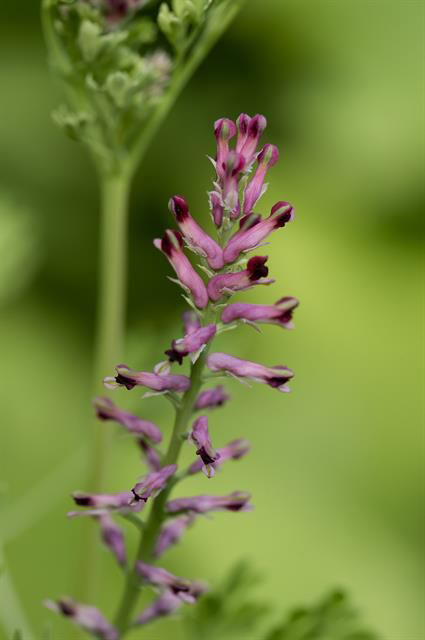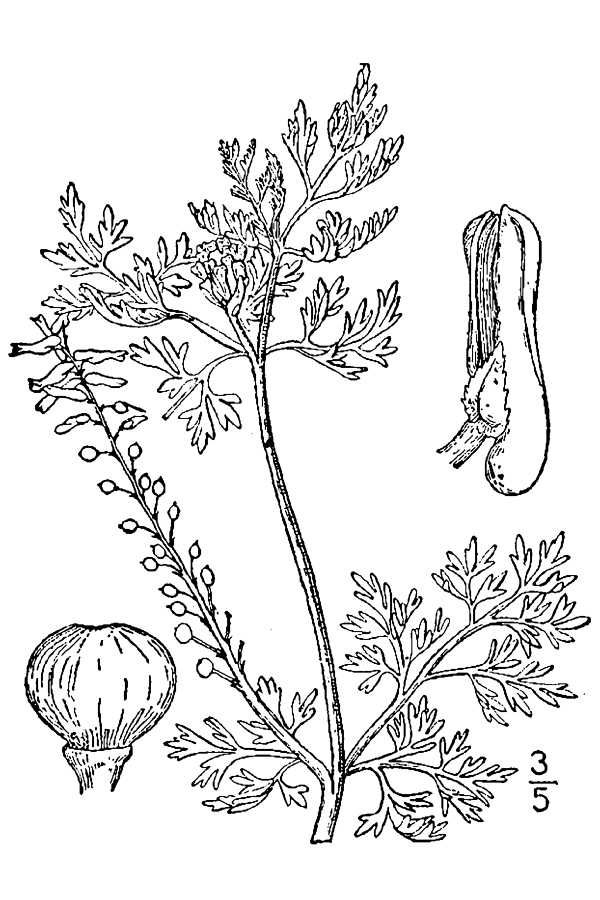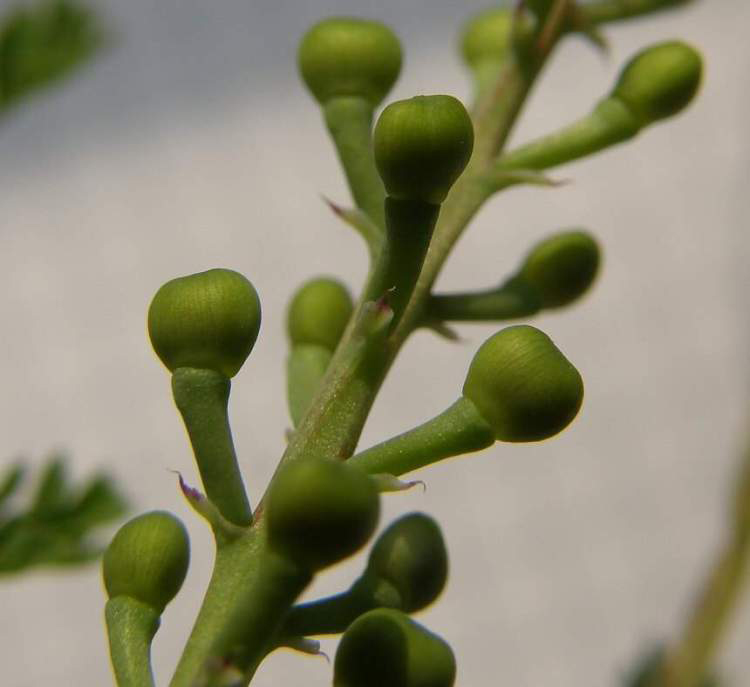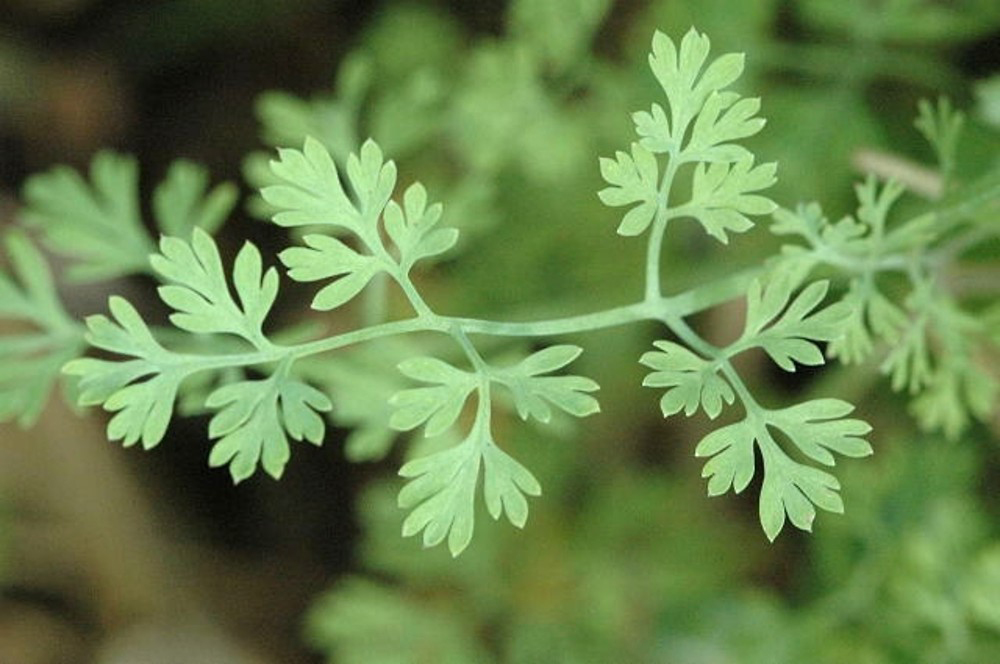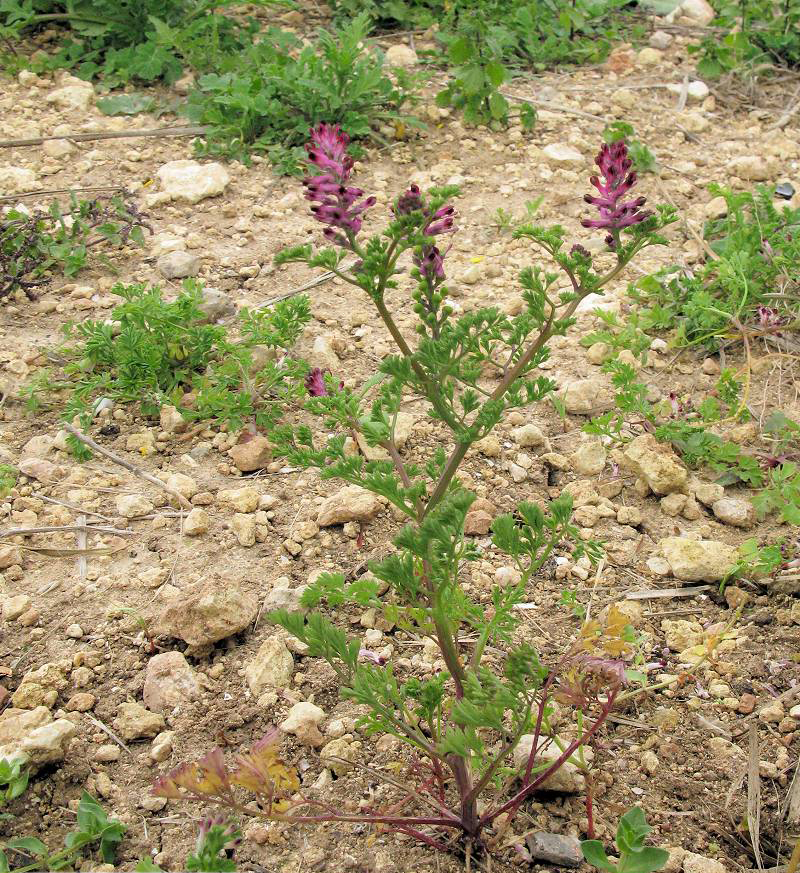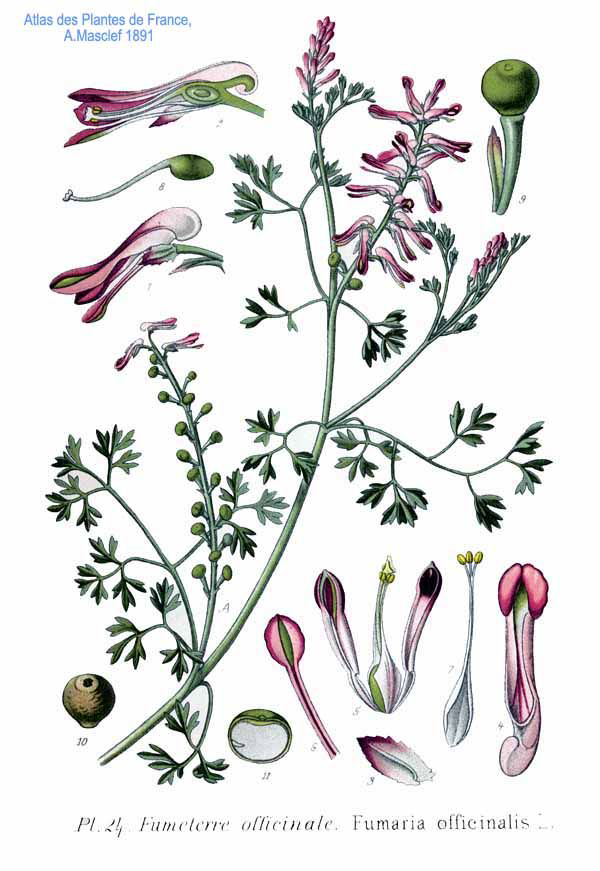Fumitory is occurred as a weed in waste places and arable land of Western Siberia, Europe and Western Asia. It is also found in Finland, Sakhalin Island, Tasmania and New Zealand. It is regarded as serious weed in Tunisia; whereas common weed in England, Bulgaria, Turkey and Russia; and as a cereal weed in France, Chile, Italy, Greece, Germany, Portugal, Yugoslavia and South Africa. Fumitory is considered as weed in other 45 countries.
The plant of Fumitory has thin stems and assorted branches which supports gray to green hued leaves. Leaves are split into triangular shaped jagged leaflets. At the terminal of branches, flowers appear in tube shaped, purplish to pink with crimson tips. Flowers blooms from May to September. Flowers are 7-9 mm in diameter having two lips. Flowers then turn to a fruit as achene which possess single seeds. Fruits are comprised of high content of compounds such as alkaloids, tannins and salts of potassium which are beneficial for human health. It is also rich in fumaric acid. The plant could be easily recognized with the presence of angled stems, pink flowers and delicately split leaves.
Flower
Flowers are short pedicled and is in dense, erect and terminal racemes opposite leaves measuring 5-8 mm long. The inner petals are dark to red and outer petals are crimson to pink in color. In the front, the outer petals are rounded.
Fruit
Fruit is slightly flattened at side, globular and green in color. It has dent in top. Fruits measures about 0.08-0.1 in (2-2.5 mm) long.
Leaves and stem
This plant measures 10 to 50 cm in height having erect, tender, branched, angular, glabrous and hollow stem. The alternate leaves are bluish green which is divided into three pinnate sections.
History
Fumitory is found in the cultivated soils of America and Europe. In early 13th century, this plant was known as fūmus terrae which means smoke of earth. Dioscorides wrote in De Materia Medica and Pliny the Elder in Naturalis Historica, two thousand years ago that the sap or late of the plant if rubbed to the eyes causes tears like an acrid smoke. It is known as kapnos in Greek.
Traditional uses
- The herb is useful for conjunctivitis, cutaneous eruptions and chronic eczema.
- Fumitory is effective for gallbladder and liver complaints.
- It is used for treating gallbladder, bile ducts and gastrointestinal tract.
- The herb is used in Folk medicine to cure skin problems, cystitis, constipation, rheumatism, infections, arthritis and arteriosclerosis.
- Also useful for the chronic and itching eczema resulted from liver disease.
- Prepare an infusion by pouring boiling water to 2-3 gm drug and strain it after 20 minutes.
- Before 30 minutes of meals, drink one cup of warm infusion to treat gallbladder complaints.
- It has valuable action on liver and effective for liver problems such as costiveness, jaundice, debility of stomach and scurvy.
- Fumitory is used for cleansing kidneys and conjunctivitis.
- It is used in Roman times for its blood cleansing activity.
- Being a diaphoretic, it is used to induce sweat.
- It stimulates muscles of intestines and also strengthens peristalsis.
- As a tea, it is an aid for eliminating intestinal parasites.
- This herb also promotes the function of gallbladder and liver.
- As it possesses antispasmodic effect, it helps to normalize bile flow.
- In Germany, this herb is used to treat biliary colic.
- Fumitory is used as a cure for psoriasis, eczema, rash, acne and scabies.
- Apply the mixture of fumitory and walnut leaves for cuts, wounds and scrapes.
- It is used as eyewash for treating conjunctivitis.
Precautions
- Avoid its use during pregnant and also by lactating mothers.
- The epilepsy and fit patients should not use it.
- It increases the effect of allopathic medication used for high blood pressure.
- Use this herb under the supervision of a health practitioner.
References:
https://www.itis.gov/servlet/SingleRpt/SingleRpt?search_topic=TSN&search_value=565200#null
http://davesgarden.com/guides/pf/go/56031/
https://npgsweb.ars-grin.gov/gringlobal/taxonomydetail.aspx?id=70905
http://pfaf.org/User/Plant.aspx?LatinName=Fumaria+officinalis
http://www.floracatalana.net/fumaria-officinalis-l-
https://www.drugs.com/npc/fumitory.html
http://www.luontoportti.com/suomi/en/kukkakasvit/common-fumitory
https://www.herbal-supplement-resource.com/fumitory-herb.html
Comments
| Fumitory Quick Facts | |
|---|---|
| Name: | Fumitory |
| Scientific Name: | Fumaria officinalis |
| Origin | Inherent to Mediterranean region, Northern Africa, Siberia and Europe. It is also introduced to South and North America. |
| Colors | Green |
| Shapes | Globular, slightly flattened at side |
| Taste | Bitter and salty |
| Name | Fumitory |
|---|---|
| Scientific Name | Fumaria officinalis |
| Native | Inherent to Mediterranean region, Northern Africa, Siberia and Europe. It is also introduced to South and North America. |
| Common/English Name | Earth Smoke, Beggary, Hedge Fumitory, Fumus, Wax Dolls, Vapor, Common fumitory, Drug fumitory, Earth smoke, Earth-smoke |
| Name in Other Languages | Dutch: Gewone Duivenkervel, Gewone Duivenkervel Subsp. Wirtgenii; German: Gewöhnliche Erdrauch, Gewöhnlicher Erdrauch; Danish: Læge-Jordrøg, English: Drug Fumitory, Fumitory, Wax-Dolls, Earth-Smoke; Arabic: guessis, shahtredj; Dutch: Gewone duivekervel, duivekervel,; Finnish: Peltoemäkki; French: Herbe à la veuve, Fumeterre officinale; Icelandic: reykjurt; Italian: erba calderugia, erba adetina, Fumaria officinalis; Portuguese: erva moleirinha, Erva-moleirinha, erva pombinha, Fumária, fel-da-terra ; Romanian: fumăriţă; Russian: dymjanka lekarstvennaja (дымянка лекарственная); Spanish: Fumaria, capa de reina, Palomilla; Swedish: jordrök Catalan: Fumària, Gallerets, Fumària oficinal, Julivert bord; Occitan: Fuma-terra, Terribustèri, Fumoterro |
| Plant Growth Habit | Annual, glaucose, herbaceous |
| Soil | Moist |
| Plant Size | 10 to 50 cm high |
| Root | Small, yellow |
| Stem | Tender, angular, erect, branched, glabrous, hollow |
| Leaves | Bluish green, alternate, double pinnate, petiolate |
| Flowering Season | April to October |
| Flower | Crimson to pink, 7 to 9 mm |
| Fruit shape & size | Globular, green, slightly flattened at side |
| Taste | Bitter and salty |
| Plant parts used | Herb, dried herb, aerial parts |
| Seed | Small, black, crestless |



